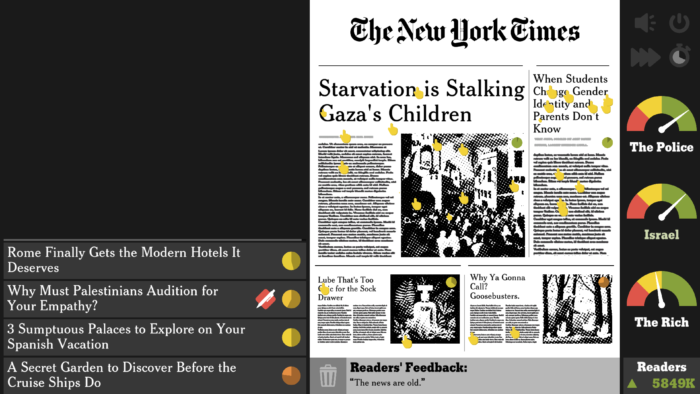The latest critique of The New York Times’ coverage of Gaza comes from an unlikely source — an indie game developer. Earlier this week, the Pittsburgh-based developer Molleindustria released its new parody game, called The New York Times Simulator.
The game puts each player in the seat of editor-in-chief. On its surface, the objective is simple: build the front page of the Times’ paper each day. That includes choosing the stories and the headlines and where they’re placed on A1.
Stories that feed into the pipeline include news on union drives at Amazon factories and the latest in climate research, alongside frothy lifestyle coverage. A headline like “Biden Said He Would Stop Drilling. Then Reality Hit,” pops up alongside a story called “Why Are Grapes Suddenly Everywhere?”
But there’s an emphasis across the game on coverage of the war in Gaza, where over 30,000 Palestinians have been killed by Israeli airstrikes, IDF forces, and humanitarian aid blockades.
In the game, decisions on how to cover the war have consequences…for the paper’s bottom line. Three “interest groups” closely observe every turn in the simulator and gauge charts display the real-time approval level of “The Police,” “Israel,” and “The Rich.”

Though readership starts at 500,000, that figure will also jump up and dip down depending on your selections. The impact of each choice is only magnified when you put that story “above the fold.” Ultimately, the goal of the game is to build a readership of 10 million subscribers, without getting fired.
There’s no clear one-to-one cause and effect in the simulator, since it never fully lays out its internal logic. But as you play, patterns become clear.
For example, one of the fastest ways to alienate your “interest groups” is putting a story front and center with an uncompromising view on Israel’s killing of Palestinian civilians, or one that labels it a genocide.
There are ways around this. Pressing the edit button reframes a story, tweaking the wording of the headline, and potentially lessening its negative impact. “Israel is Starving Gaza’s Children” suddenly changes to “Starvation is Stalking Gaza’s Children.”
That is a real opinion piece headline that ran at the Times in February, by the way. In fact, Molleindustria’s release notes called the entire game “ripped from the headlines.” And many of the most damning ones in the simulator are pulled straight from the source.
Alongside the game, the developers released a public Google Sheet linking out to 107 stories used in the simulator. The majority of Times headlines are verbatim ones that have been published in the past year. A handful, though, have been slightly altered or pulled from other major news outlets, including CNN, NBC, and The Washington Post.
Headline edits are, in part, lifted from the media accountability tracker, NewsDiffs, which runs the bot account, Editing TheGrayLady on X.
The New York Times Simulator is just the latest satire game from cult indie developer Molleindustria, who has been publishing experimental fare for nearly two decades. The moniker is used by Paolo Pedercini, who is also a professor of game design at Carnegie Mellon University. In the past Pedercini has taken aim at McDonald’s in a Farmville-style depiction of a cattle slaughterhouse, and the fossil fuel industry in a globe-trotting game of resource extraction called Oiligarchy.
The New York Times Simulator is also riffing on games outside the studio’s archive, which have similarly tried to capture the ethical and business decisions that go into running a news publication.
The release notes mention the 2012 game The Republia Times as inspiration. That game similarly puts players in the role of editor-in-chief, sifting through headlines to build the front page of a fictional paper of record. But players in that game are up against the censorship regime of the fictional authoritarian Republia government.
This latest update, Pedercini says, isn’t to call out censorship as much as it is to “train players to quickly identify common spinning and framing techniques.”
In particular, he notes the routine use of the passive voice in Times headlines, which remove the state of Israel or police in the U.S. as actors in stories about violence. A package profiling Palestianians killed in Israel’s bombardments, for example, is headlined “Lives Ended in Gaza.” In the domestic coverage, he points out the frequent use of biased euphemisms, like “officer-involved shooting.”
“I originally wanted to make parody headlines,” writes Pedercini. “But I just couldn’t come up with anything more shameless and contrived than what’s already out there.”
A previous version of this story referred to over 30,000 deaths of Palestinian civilians, but, as NPR notes, the death toll “does not make clear how many militants are among the dead.” The New York Times reported on February 29 that “many experts say the official toll is very likely an undercount, given the difficulty of accurately tallying deaths amid unrelenting fighting, communications disruptions, a collapsing medical system and people still believed to be under rubble.”
2 comments:
온라인카지노
Only a smiling visitant here to share the love (:, btw outstanding design. “He profits most who serves best.” by Arthur F. Sheldon.
Trackbacks:
Leave a comment